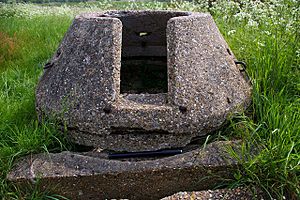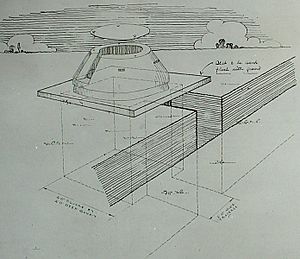Tett turret facts for kids
Quick facts for kids Tett Turret |
|
|---|---|
| Deployed throughout the United Kingdom | |

Surviving Tett Turret at RAF Hornchurch. Light coming through one of several spy-holes can be seen opposite the embrasure.
|
|
| Type | Pillbox |
| Site history | |
| In use | Second World War |
| Materials | Concrete |
| Garrison information | |
| Garrison | 1 or 2 |
The Tett turret was a special type of small fort built in Britain during the Second World War. It was designed to help defend the country if enemies tried to invade. This unique structure was named after its inventor, H.L. Tett.
It was a small, round concrete structure. The most interesting part was that it could spin around! It sat on a special spinning base, like a giant ball bearing. This allowed soldiers inside to turn it easily. Early versions were placed over a pit made from a large concrete pipe.
What Was a Tett Turret?
The top part of the turret was a cone shape, about 20-inch (50 cm) high. It was made of strong, reinforced concrete. Each turret had one opening for a weapon, called an embrasure. It also had several small holes, like peepholes, for soldiers to look out.
Why Was This Design Special?
The Tett turret had several good points.
- It used less concrete and steel than bigger forts.
- It was easy to hide because it was small.
- It was mostly built in factories, so it could be set up quickly.
- Because the turret could spin, soldiers could aim their weapons in any direction. This was a big advantage over regular forts, where weapons could only fire in one direction.
- It was also quite cheap to build.
What Were the Challenges?
Even with its good points, the Tett turret had some problems.
- The War Office (the government department in charge of the army) thought it was too small inside.
- It wasn't strong enough to stop heavy enemy fire.
- Soldiers inside were alone, making it hard for commanders to give orders.
- The open top made it easy for enemies to throw grenades inside.
- The biggest problem was that the only way in or out was through the top. This meant soldiers had to expose themselves to enemy fire to escape. It was designed for a fight to the end.
The company that made them, Burbridge Builders, tried to fix these issues. They created a new version. Instead of a pipe pit, it sat on a concrete slab over an underground room. This room could be reached by a tunnel or trench from behind. This new design meant soldiers could get in and out more safely.
Where Can You See Tett Turrets Today?
Tett turrets are very rare now. Only a few were ever made, and even fewer still exist.
- Two Tett turrets can be seen at RAF Hornchurch. This area is now a park called Hornchurch Country Park. These turrets were studied for a TV show called Two Men in a Trench. During filming, three more hidden turrets were found nearby!
- Two very well-preserved turrets were recently found in Docking, a village in Norfolk. These are special because they are connected by a concrete tunnel. This tunnel is about 15 feet long and has another small tunnel branching off it. The turrets at Docking are also unique because their gun ports are different from the Hornchurch ones. These Docking turrets are now protected as important historical sites.
- Other examples have been found in Woolmer Green and North Mymms in Hertfordshire.
Images for kids



